
The TOEFL Speaking section can be a challenge for many test takers, especially when it comes to the Integrated Speaking TOEFL questions. These complex tasks test not only your English-speaking skills but also your reading and listening skills. So how can you ensure you’ll get a high score on them on test day?
In this guide, we give you an overview of the TOEFL Integrated Speaking tasks and explain what to expect on each task. We also provide you with 11 study resources and six expert tips so that you can walk away with a high TOEFL Speaking score.
Feature image: lincolnblues/Flickr
What Are the Integrated Speaking TOEFL Questions?
On the TOEFL Speaking section, there are six questions, or tasks, you must complete. Tasks 1 and 2 make up the Independent Speaking section, while tasks 3-6 make up the Integrated Speaking section. These four Integrated Speaking tasks require you to combine other skills—namely, reading and listening—with your ability to speak English. (By contrast, the Independent Speaking tasks only require you to read a brief prompt and then explain your opinion.)
Multiple human raters grade each Integrated task using a scale of 0-4 in whole points. For each task, the raters’ scores are then averaged together to get a single raw score (also on a scale of 0-4, though decimals are possible). The sum of your four Integrated scores is later averaged with your Independent scores and converted to a final Speaking score on a scale of 0-30. Our guide to the Speaking scoring system (coming soon) explains this process in more detail.
According to the official TOEFL Integrated Speaking rubric, a 4 response “is highly intelligible and exhibits sustained, coherent discourse,” whereas a 1 response “is very limited in content or coherence or is only minimally connected to the task.” (A 0 response means that you did not respond or did not answer the prompt appropriately.)
So what does each Integrated Speaking task require you to do? Let’s take a look.
By the way: we have built the world's best online TOEFL course. Get online practice (TPO-sytle!) and individual grading and feedback on Speaking and Writing.
To be fair, it's possible to get a good TOEFL score studying alone. But PrepScholar is the world's most effective TOEFL course if you are worried about the TOEFL and are struggling to improve your score.
Learn how you can improve your TOEFL score by 15 points today.
Speaking Task 3
For task 3, you must read a passage, listen to a conversation, and then record your response. All together you’ll have:
- 45-50 seconds to read the passage
- About 60 seconds to listen to the conversation (audio clip times vary)
- 30 seconds to prepare your response
- 60 seconds to speak
The reading passage for this task will typically be some sort of campus flyer or announcement that describes a campus issue or change. The audio clip will focus on two people (usually two students) talking about the campus situation and offering their opinions on it.
Your task is to summarize one speaker’s opinion on the campus situation. (Note that unlike the Independent tasks, you will not be giving your own opinion but rather explaining someone else’s opinion.)
Here is an example of task 3:
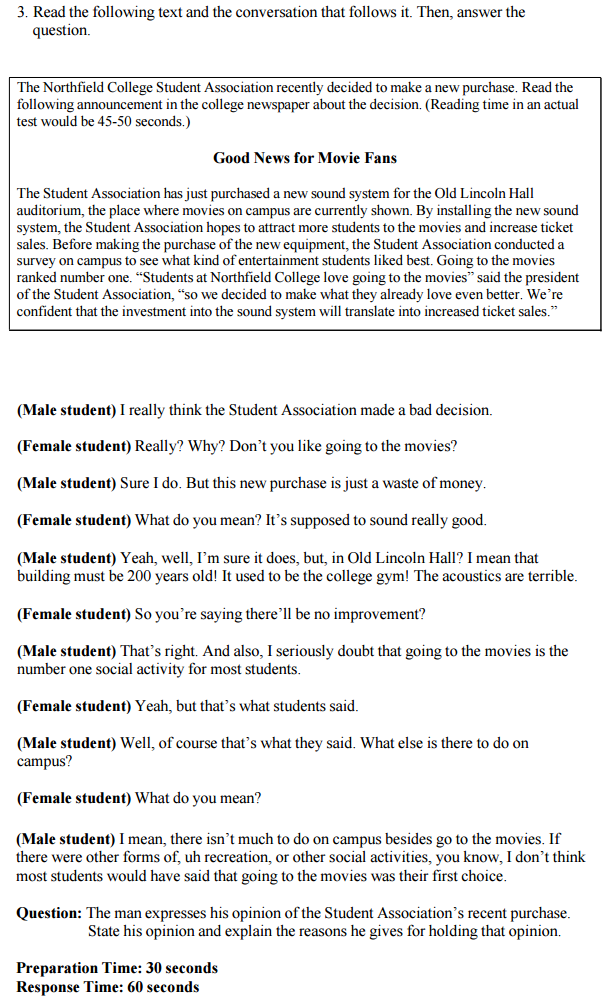

For a more detailed breakdown of TOEFL Speaking question 3, check out our video below and the rest of PrepScholar’ TOEFL Speaking Series on YouTube.
Speaking Task 4
Task 4 is similar to task 3 in that you must read a passage, listen to an audio clip (in this case, a lecture instead of a conversation), and record your response. You’ll have the same time restrictions as you do on task 3:
- 45-50 seconds to read the passage
- About 60 seconds to listen to the lecture (audio clip times vary)
- 30 seconds to prepare your response
- 60 seconds to speak
Compared to task 3, task 4’s biggest difference is its focus on academic course content. The passage you read will focus on an academic term or concept and usually comes from a university-level textbook. You’ll then listen to a lecture on the same topic.
Your task is to explain a particular concept or term discussed in both the passage and lecture.
Here is an example of task 4:
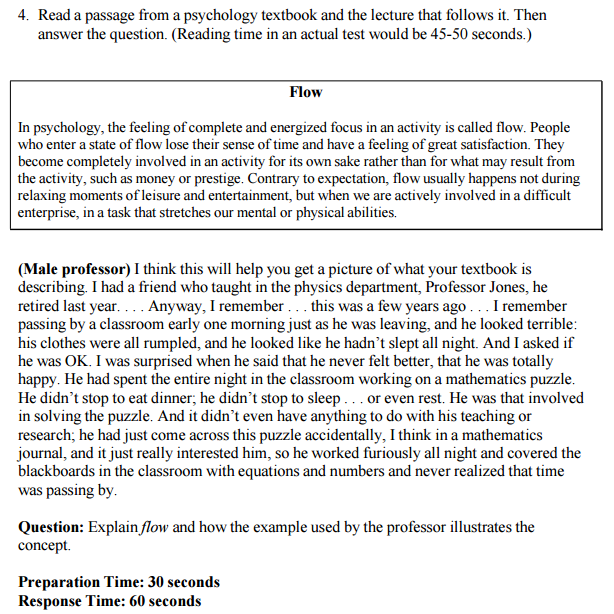
Want more tips for this type of question? Check out our video analysis:
Speaking Task 5
Task 5 differs greatly from the format for tasks 3 and 4 in that there is no reading passage. However, you must still listen to an audio clip—in this case, a conversation. In addition, some of the time limits are slightly different from those for tasks 3 and 4. In total, you’ll have:
- About 60-120 seconds to listen to the conversation (audio clip times vary)
- 20 seconds to prepare your response (that’s 10 seconds less than you’ll have on tasks 3 and 4!)
- 60 seconds to speak
For this task, you must listen to a conversation revolving around a campus situation (similar to the content of task 3). Usually, the topic will be an issue specifically related to campus life. In the audio clip, the speakers will introduce the problem and then offer various solutions.
Your task is to summarize the issue and explain which solution you believe is the best one.
Here is an example of task 5:
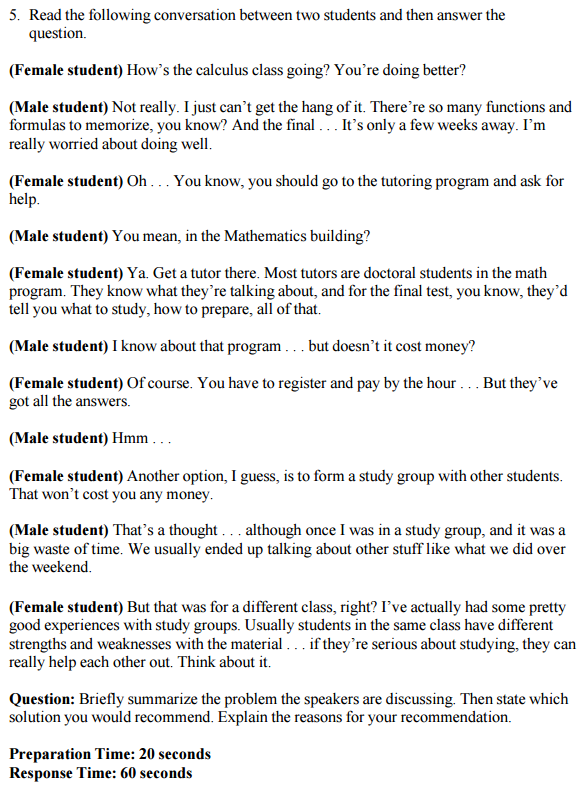

If you’re still worried about question 5, we offer even more tips in our detailed video explanation:
Speaking Task 6
Task 6 is structurally identical to task 5 in that there is no reading passage. But with this task, you must listen to a lecture instead of a conversation. All of the time limits are the same as those for task 5, meaning you’ll have:
- About 60-120 seconds to listen to the lecture (audio clip times vary)
- 20 seconds to prepare your response
- 60 seconds to speak
Unlike task 5, which focuses on a campus situation, task 6 focuses on academic course content (similar to the content of task 4). The entire audio clip will revolve around a university lecture, which can range in topic from science and history to literature and art.
Your task is to summarize all or part of the lecture.
Here’s an example of task 6:
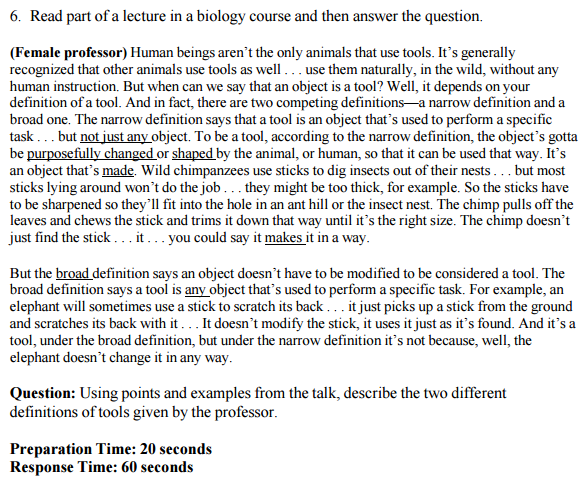
Get more tips for TOEFL Speaking question 6 with our video breakdown:
Recap: The 4 Integrated Speaking TOEFL Tasks
To summarize, here are the primary features of the four Integrated Speaking TOEFL tasks:
| Task 3 | Task 4 | Task 5 | Task 6 | |
|
Reading + Listening |
Listening | |||
| Topic | Campus Situations | Academic Course Content | Campus Situations | Academic Course Content |
| Score Range | 0-4 | 0-4 | 0-4 | 0-4 |
| Audio Type | Conversation | Lecture | Conversation | Lecture |
| Audio Length | About 1 min | About 1 min | About 1-2 mins | About 1-2 mins |
| Reading Time | 45-50 sec | 45-50 sec | — | — |
| Preparation Time | 30 sec | 30 sec | 20 sec | 20 sec |
| Speaking Time | 1 min | 1 min | 1 min | 1 min |
| Prompt | Summarize a speaker’s opinion on a campus-related situation | Explain a specific term or concept from the passage and lecture | Summarize a campus-related issue and then choose a solution | Summarize a lecture or part of a lecture |

11 Resources for TOEFL Integrated Speaking Practice
To do well on the TOEFL Speaking Integrated task questions, you need to understand exactly what you’re being tested on—and of course practice, practice, practice! Below, we give you our picks for the best resources for high-quality TOEFL Integrated Speaking practice and guidance.
Want to improve your TOEFL score? We have the world's leading TOEFL course.
Built by world-class instructors from Harvard and MIT, the course offers individual review, interactive lessons, and realistic online praactice, at an affordable price! It's the fastest way to get your target TOEFL score.Official Resources
Let’s start with the best of the best. Official resources (i.e., those created by ETS) offer the highest quality practice questions and tips for TOEFL Integrated Speaking tasks, both online and offline. Best of all, most are completely free!
TOEFL iBT Interactive Sampler
This free, downloadable software offers an extremely realistic TOEFL test-taking experience. Available for Windows only (my apologies if you have a Mac!), the Interactive Sampler contains an abbreviated TOEFL practice test that includes two Integrated Speaking questions.
The first Integrated task uses the form of task 4: you must read a passage on an academic topic, listen to a lecture, and then explain a concept. The second Integrated task uses the form of task 5: you must listen to a conversation about a campus issue and then explain which solution you think is best.
Unfortunately, the sampler doesn’t grade your Speaking responses; however, it does provide you with sample low- and high-scoring responses. I recommend listening to these so you can get a better understanding of how you’ll be graded on the Integrated tasks and what kinds of mistakes to avoid.
TOEFL iBT Quick Prep
Another free resource, Quick Prep is a four-volume collection of PDFs and MP3 files offering a high-quality assortment of TOEFL Reading, Listening, Speaking, and Writing prompts.
Altogether, you’ll get eight Integrated Speaking TOEFL questions. Here are the Integrated question types that come with each volume:
Be aware that for volumes 1 and 2, the audio clips for the Integrated Speaking tasks are only available as transcripts, not MP3 files. As a result, you’ll get a more realistic Integrated Speaking experience by using volumes 3 and 4.
TOEFL iBT Sample Questions
This free PDF is similar to Quick Prep but far less extensive. With this resource you get about half a TOEFL practice test, with all four types of Integrated Speaking tasks.
Unfortunately, there are no MP3 files for the Integrated Speaking audio clips, so once again you’ll need to read transcripts, making it a less realistic testing experience. Additionally, all of the examples we’ve given you above were taken directly from this PDF, so you won’t be getting anything new.

TOEFL Online Practice (TPO) Tests
Want to practice Integrated Speaking TOEFL questions in the context of a full-length exam? Then look no further! TPO tests are retired TOEFLs and therefore offer the most realistic TOEFL test-taking experience you can get online. And because these are all full-length tests, each comes with a complete set of four Integrated Speaking tasks.
But there are a couple of drawbacks to this resource. For one, TPO tests are pretty costly: 45.95 USD a piece to be exact! The truth is that you can get equally solid TOEFL Speaking Integrated task questions by using the other official resources on this list, so only buy a TPO test if you’re certain it’ll help you prepare for test day.
Furthermore, although you’ll receive Speaking scores for your responses, these may not be entirely accurate. This is because TPO tests use a computer program called SpeechRater instead of human raters to grade your responses. Therefore, it’s highly possible that this program won’t be able to take into account slight nuances in your speech when scoring your responses.
Inside the TOEFL Test YouTube Videos
ETS maintains a helpful series of YouTube videos called “Inside the TOEFL,” and two of these apply directly to the Integrated Speaking TOEFL tasks.
One video centers on tasks 3 and 5 (campus situations) and the other on tasks 4 and 6 (academic course content). Both videos go over what the tasks consist of and how to score highly on them; they also give examples of high-scoring responses.
The only major con is that you won’t get any new tasks with this resource since all of them come from the Sample Questions PDF above.
Tasks 3 & 5 (Campus Situations)
Tasks 4 & 6 (Academic Course Content)
Official TOEFL Prep Books
ETS offers many prep books you can use for high-quality TOEFL Integrated Speaking practice (in addition to Reading, Listening, and Writing practice).
The Official Guide to the TOEFL Test is a comprehensive resource containing three full-length practice tests and hundreds of realistic practice questions for all sections of the exam. You can listen to sample Speaking responses (ranging from low level to high level) using the CD-ROM as well as read explanations telling you what important points to include in your Speaking responses.
Other quality resources include Official TOEFL iBT Tests Volumes 1 and 2. These books offer a total of 10 full-length practice tests, all accessible by both paper and computer to suit your needs. Like The Official Guide, with these books you can listen to sample responses to see what kinds of points you should be making in your own responses to get a high Speaking score.
Official TOEFL prep books are reasonably priced, generally costing no more than 25 USD.
Want to improve your TOEFL score by 15 points?
Registration is now open for our best TOEFL course. We guarantee your money back if you don't improve your TOEFL score by 15 points or more.
PrepScholar TOEFL is online and it features thousands of practice questions and 1-on-1 Speaking and Writing review and feedback.
Unofficial Resources
While official TOEFL materials are no doubt excellent resources for TOEFL Integrated Speaking practice, the same can’t be said for unofficial materials. This is because many unofficial TOEFL resources are low quality and fail to offer realistic Integrated Speaking TOEFL questions and responses.
Nevertheless, there are a few solid options out there you can try! Here, we introduce the best unofficial TOEFL Integrated Speaking resources currently available. Similar to the list above, most of the following resources listed here are entirely free!
Unofficial TOEFL Prep Books
After official resources, the next-best resource for TOEFL Integrated Speaking practice is highly reviewed TOEFL prep books. These unofficial guides can be especially useful if you’ve already exhausted all of the Integrated Speaking prompts contained in the official materials listed above.
The trick is to make sure you’re getting a high-quality TOEFL prep book. I recommend searching for reputable test-prep companies, such as The Princeton Review, Barron’s, and Kaplan. You can also check out our in-depth review to see the top TOEFL prep books currently available on the market.
Prices for unofficial prep books vary but are usually anywhere from 10 to 30 USD, making them cheaper than a single TPO test!
Magoosh TOEFL Speaking App
This free app by Magoosh is an incredibly helpful resource that allows you to hone your Integrated Speaking TOEFL skills conveniently and fast.
Available for iPhone and Android, this TOEFL Speaking app offers a full Speaking section test. And the content is superb: the four Integrated tasks contain realistic reading passages and extremely high-quality audio clips. You can also record your responses and later evaluate them by comparing them to sample high-scoring responses.
The only drawback is that you must make a Magoosh account to be able to use the app and track your progress. But the account is easy to make and free, so I think it’s worth making one just for the app alone!
Exam English
This website is an excellent unofficial (and free!) resource that’s ideal for TOEFL Integrated Speaking practice.
It contains a full Speaking section, and its Integrated Speaking passages and audio clips are all fairly high quality, mimicking those on the real TOEFL. There are also audio transcripts for the clips, which are particularly useful if you’re having trouble understanding what’s being said.
Additionally, high-scoring responses are available as both audio clips and transcripts. But even though these responses are clear and easy to understand, their pacing is often a little slow and robotic sounding. What’s more, nearly all are longer than 60 seconds, making them unrealistic for the TOEFL.

English Club
Another solid website, English Club offers a complete Speaking section. Like Exam English, the Integrated Speaking tasks come with audio clips (including transcripts) and sample responses (again, with transcripts).
One major con of this website, however, is that the sample responses are all pretty short. Although you have 60 seconds to respond to each Integrated task, some of the sample responses are only around 20-30 seconds long, making them inaccurate depictions of high-scoring responses.
In addition, many of the audio clips contain static and background noise, so they are somewhat difficult to understand.
PrepScholar TOEFL Integrated Speaking Topics
Finally, we at PrepScholar offer you two original TOEFL Integrated Speaking tasks. One is a task 3 sample containing a reading passage and a transcript of a conversation, and the other is a task 6 sample containing a transcript of a lecture.
As you practice with our prompts, make sure you adhere to the official time limits so that your Integrated Speaking practice is as authentic as possible.
For task 3, give yourself:
- 45 seconds to read the passage
- 60 seconds to read the conversation transcript
- 30 seconds to prepare your response
- 60 seconds to speak
For task 6, give yourself:
- 120 seconds to read the lecture transcript
- 20 seconds to prepare your response
- 60 seconds to speak
Try to record your responses with a smartphone or other recording device. Once you’ve finished both tasks, use the official Speaking rubrics to score your responses.
How to Prepare for TOEFL Integrated Speaking: 6 Tips
In order to do well on Integrated Speaking, you must know how to prepare effectively for it. In this section, we give you six tips guaranteed to help you score highly on all four Integrated Speaking TOEFL tasks.
#1: Refine Your Pronunciation
One of the most important components of TOEFL Speaking is being able to speak English clearly. This is why you’ll need to spend some time working on your English pronunciation, particularly on any sounds that you feel you’ve yet to master.
Oftentimes, the most difficult English sounds for you will be those that aren’t used in your native language. For example, native Japanese speakers might find the “v” sound difficult to pronounce, while native French speakers might struggle to pronounce the “h” sound at the beginning of words.
Some of the English sounds most commonly considered challenging to pronounce include:
- The hard “th” (as in “think”)
- The soft “th” (as in “that”)
- R
- L
- H
- V
- J
- W
I suggest making a list of English words and sounds you want to practice. So for example, if you’re struggling to pronounce the hard “th,” you could make a list that includes the following words and phrases:
- Think
- Thing
- Thank you
- Throw
- Math
- Month
- With
You can also use YouTube to look for the sounds you wish to practice. YouTube usually offers a wide variety of language tutorial videos, many of which teach you how to pronounce common English sounds.

#2: Hone Your Listening and Reading Skills
Because you’ll need to read (for tasks 3 and 4) and listen to audio clips (for all Integrated tasks), it’s imperative you hone your English reading and listening skills in addition to your speaking skills.
For reading, make sure you’ve got a strong foundation in English vocabulary, especially academic vocabulary. I also recommend reading various sample TOEFL reading passages, which we discuss more in our guide to TOEFL reading passages.
For listening practice, try watching English news and movies to get a feel for how native speakers converse with one another. One solid resource to start with is VOA Learning English, a free news website targeting English-language learners. With this resource, you can listen to videos and read articles entirely in English.
#3: Practice Speaking With Native English Speakers
By far, the best way to become a good English speaker is to actually speak it! This is why it’s a helpful idea to look for native English speakers in your area with whom you can practice your English conversational skills. As a reminder, native English speakers are those whose first language is English, regardless of where they were born or grew up.
If you’re not sure where to find native English speakers, try looking for English-language groups in your area. Meetup is a handy website you can use to arrange get-togethers with people who have similar interests as you. In this case, you could look for language groups to join or even create one of your own if there isn’t one already in your area.
Another option is to do online video chat lessons with native English speakers. You can look for English tutors through various language-learning websites, such as italki, Verbalplanet, and Live Lingua.
These lessons aren’t free, of course, so be prepared to pay. Fees vary depending on the teacher and the length and frequency of your sessions.
#4: Learn How to Take Notes Effectively
The time you’re given on Integrated Speaking to read passages and listen to audio clips is extremely limited, so make sure you’re always taking notes (coming soon)—and taking them well!
For tasks 3 and 4, take notes during both the passages and audio clips. Tasks 5 and 6 won’t give you any passages to read but will have audio clips you must listen to, so try to take detailed notes as you listen.
As you take notes on the passages and audio clips, include the following:
- The main point or idea of the passage/audio clip
- Who says what
- Any important terms or concepts
- Any definitions or explanations
- Any solutions or decisions made
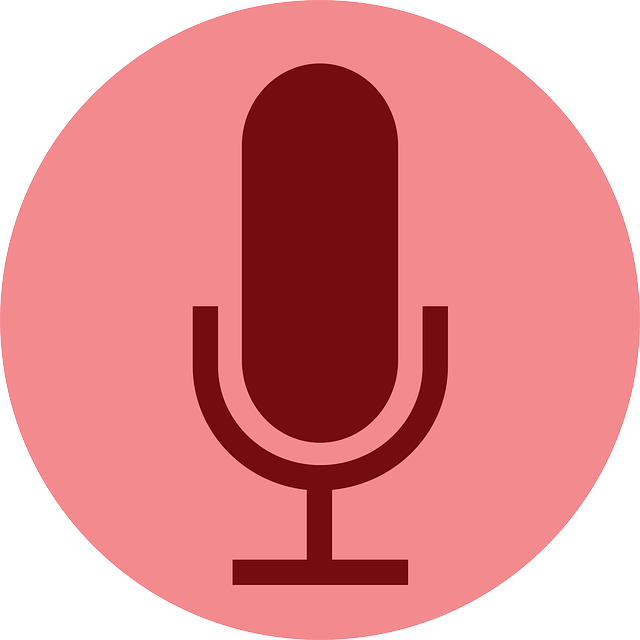
#5: Record Yourself & Evaluate
If you’re not sure whether your responses are good enough, try playing the part of the grader. You can do this by recording your responses and listening back to them to evaluate how well you were able to answer the prompts.
Start by finding some sample TOEFL Integrated Speaking questions (official resources are a great place to start!). Then, time yourself using the official time restrictions for each task (see tasks 3-6 above for details). Once you’ve recorded your response, play it back and use the Integrated Speaking rubric to assign yourself an appropriate score.
If possible, record yourself in a slightly loud environment, such as a cafe or mall, to ensure your responses are easy to make out over background noise. This is important since test takers on test day often get to the Speaking section at the same time, making the testing room louder than normal.
As you grade yourself, try to be unbiased by separating yourself from what you’ve recorded. Ask yourself the following questions as you evaluate your responses:
- Are you able to answer the prompt fully and accurately?
- Do you speak too fast? Too slowly?
- Do you repeat yourself?
- Do you use correct grammar and pronunciation?
Alternatively, you can ask a native English speaker to grade your responses and give you tips on how to improve. Using another set of ears allows you to have a less biased perspective of your responses.
#6: Use a TOEFL Speaking Template
If you’re struggling to speak at a natural pace or can’t frame your responses in an easy-to-follow manner, consider practicing with a TOEFL Speaking template. While templates do not tell you exactly what to say (they can’t predict what prompts you’ll have!), they do give you a general framework with which to work.
They also teach you how to pace yourself so that you spend less time thinking about what to say next and more time fully answering the prompt. Just be careful not to sound too robotic in the end—you’ll lose points if your response is unnatural or overly rehearsed!
Conclusion: What Is TOEFL Integrated Speaking?
The Integrated Speaking TOEFL section consists of four tasks (tasks 3-6). The first two each contain a reading passage and an audio clip, while the latter two each contain a (usually longer) audio clip without a reading passage.
To score highly on the Integrated Speaking tasks, always practice with high-quality resources. Most official resources are free and come with a realistic assortment of practice questions and sample responses. Solid unofficial resources include highly rated prep books, apps, and websites.
When preparing for Integrated Speaking, it’s important to learn the most helpful tips available. Some of our top tips include honing your pronunciation, improving your reading and listening skills, and conversing with native English speakers.
Once you understand how to prepare effectively for the Integrated Speaking tasks, you’re sure to get a great score on test day!
What’s Next?
Want more tips for TOEFL Speaking? Our guide teaches you how to ace the TOEFL Speaking section and offers tons of expert prep and test-day tips.
Looking for a different way to study TOEFL Speaking? Check out PrepScholar’s TOEFL Speaking Series on YouTube.
Craving TOEFL Speaking practice? Check out our collection of the eight best TOEFL Speaking practice tests currently available online.
Got questions about the TOEFL Speaking scoring system? Learn everything there is to know about how Speaking is scored and what this scoring system ultimately means for you.
Ready to improve your TOEFL score by 15 points?
Download our best TOEFL Strategy eBook (valued at $14.49) for FREE! Learn the top 5 strategies you must know to improve your TOEFL score. Download it for free now:
